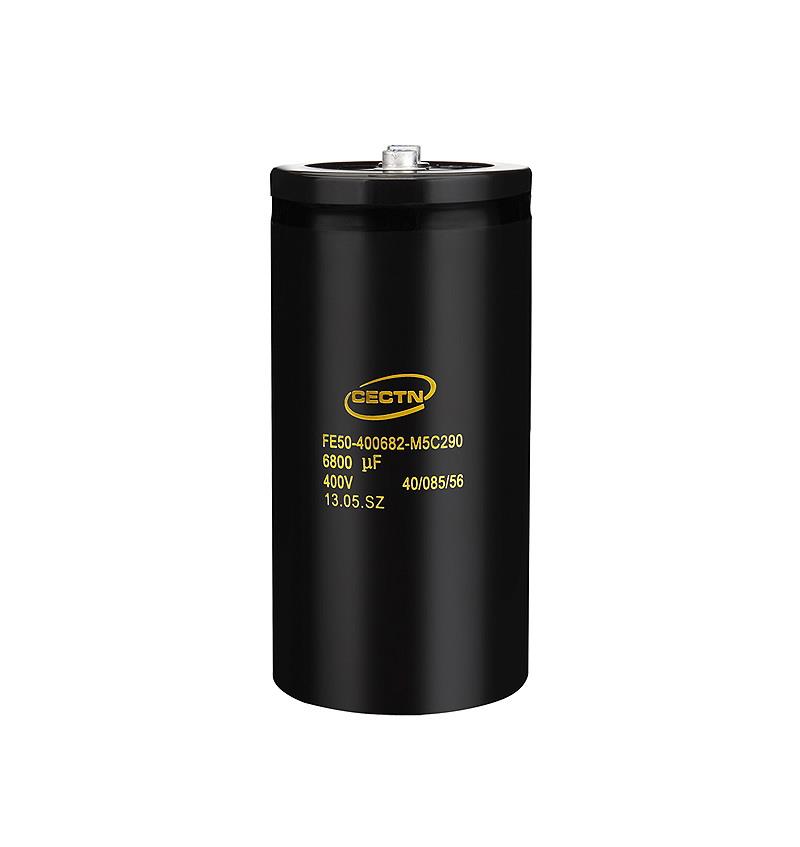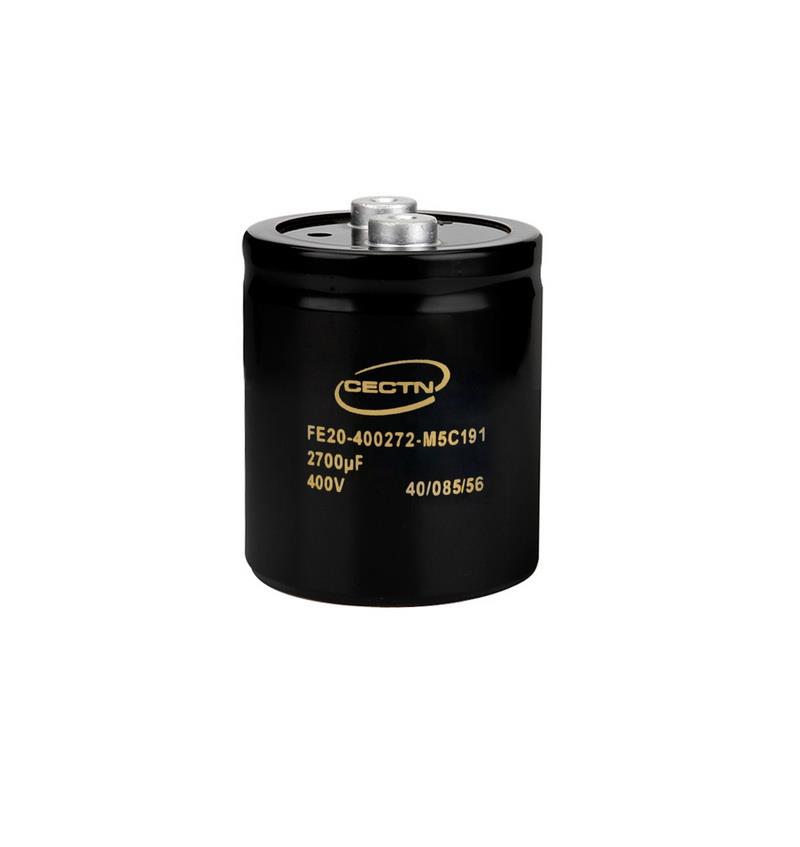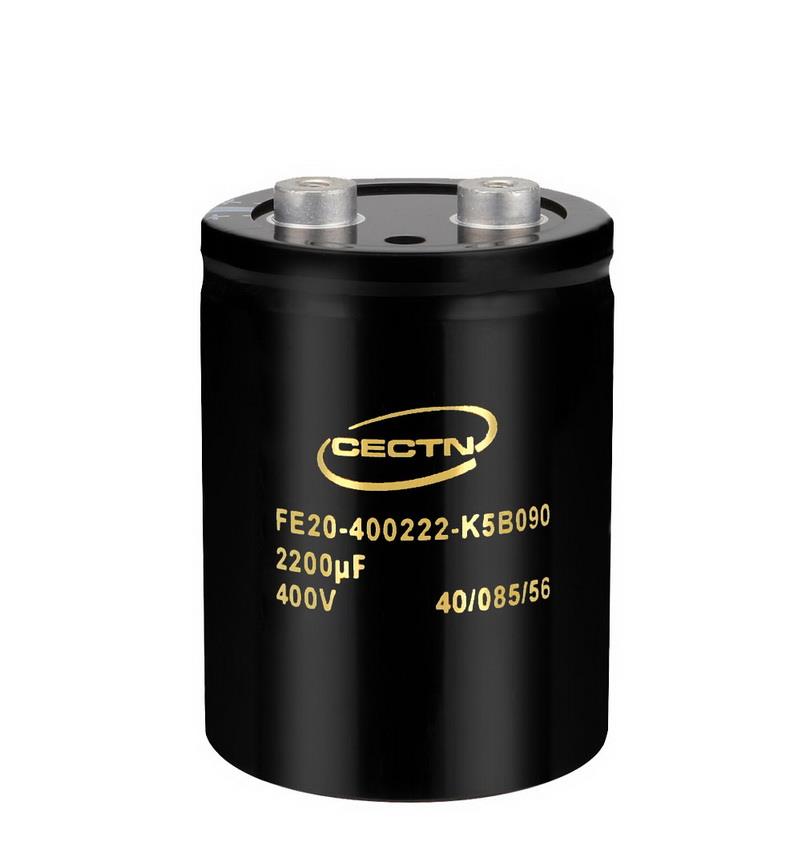Home » FORUM » Capacitor Academy » Basic knowledge
Application of aluminum electrolytic capacitor in new energy field
source:CECTN Technology Co., Ltd.Editor:View mobile address
Scan! Scan!
Scan!
Click:1-Time:2021-01-05 10:00:26【large
in Small】
 Scan!
Scan!
As a new energy, solar energy can provide clean and pollution-free energy for our life. Because the current generated by photovoltaic power generation system is DC, but the civil power is mainly AC power supply, and solar power generation will eventually move to grid operation, which means that solar power generation must convert DC to AC through inverter to drive household appliances and other loads. Therefore, inverter plays an important role in solar power generation system.
The main function of the inverter is to convert the variable DC voltage input of the power supply into a non-interference AC sine wave output, which can be used by the equipment and fed back to the power grid.
1、 Requirements of photovoltaic inverter for solar power generation
For engineers who are familiar with power management, what are the key points of designing inverter for solar power generation system? First of all, in terms of the use of the existing photovoltaic system inverters, they can only be used for 5 to 10 years, while the service life of photovoltaic panels is as long as 25 years, and the inverter has become the lowest reliability module in the photovoltaic system. IRs Alberto Guerra proposes that designers must consider the service life of photovoltaic system inverters. Solar inverter technology industry has a high expectation for the product life, generally can guarantee 20 to 25 years of service life, so special emphasis on the reliability of each component.
2、 The key to improve the life of photovoltaic inverter
The life of photovoltaic inverter depends on the reliability of its components. Although semiconductor components usually reach this level of reliability, it may be a challenge for passive components, especially electrolytic capacitors. Improving the reliability of electrolytic capacitor has become one of the keys to improve the reliability of photovoltaic inverter.
3、 The role of electrolytic capacitor in photovoltaic inverter
Photovoltaic inverter can be regarded as a special purpose inverter powered by DC power supply, with the output frequency of 50 Hz or 50 Hz synchronized with the grid. There is no current pulse of rectifier circuit generated by rectifier, so the function of aluminum electrolytic capacitor on DC bus is DC bus capacitor or "DC link" capacitor, which is used to absorb the switching frequency extremely high harmonic current generated by inverter and the third harmonic current and high harmonic current of output frequency.
4、 Requirements of photovoltaic inverter for electrolytic capacitor
1. High voltage
In general, high-power photovoltaic inverter, the converted AC is directly connected to the high-voltage power grid, but from the perspective of safety regulation, the output voltage of photovoltaic battery pack is generally not higher than 900v, so two 450V electrolytic capacitors can be selected in series, but in order to improve safety, two 500V electrolytic capacitors can be selected in series. Therefore, high voltage capacitors are needed to reduce the series connection of capacitors and improve the reliability.
2. High ripple resistance
In general, the current flowing through the capacitor of photovoltaic inverter is 0.44 times of the RMS output current of inverter. For example, the output voltage of photovoltaic inverter is 250V, the output current corresponding to 1kW output power is about 2.54a, and the current flowing through DC bus capacitor is 1.12a. The DC bus capacitor of 100kW photovoltaic inverter needs to flow 112a RMS current, and the rated current of the selected capacitor should not be lower than this value. If the rated current of one electrolytic capacitor can not meet the requirements, multiple electrolytic capacitors should be selected in parallel to obtain the required current value. Therefore, a single electrolytic capacitor with high ripple resistance is required to reduce the number of parallel capacitors and improve the overall reliability.
3. Long life
In the solar power generation system, the service life of photovoltaic panels is as long as 25 years, while the inverter becomes a photovoltaic system, which can only be used for 5 to 10 years, so the life of photovoltaic inverter system in solar power generation system is required to be 25 years. For the passive component aluminum electrolytic capacitor, its negative electrode is electrolyte, which will slowly dry up and fail with the increase of service time. This is bound to require the electrolytic capacitor industry to produce a longer life electrolytic capacitor to meet the requirements of photovoltaic inverter.
At present, the long-life aluminum electrolytic capacitor on the market is 85 ℃ and 5000 hours, while the ES6 series of bit can guarantee 85 ℃ and 6000 hours life under the same conditions, and the ripple resistance is 1.7 times of that of ordinary long-life type, which improves the service life and ripple resistance of electrolytic capacitor and meets the requirements of ordinary photovoltaic inverter. Bits el20 ultra long life electrolytic capacitor has a life of 85 ℃ and 20000 hours, and its ripple resistance is 1.9 times that of ordinary long life type. It can fully meet the long life requirements of photovoltaic inverter, greatly improve the reliability level of photovoltaic inverter, and meet the requirements of solar power generation system. With the continuous progress of new energy field and related industries, we believe that solar power technology will also develop rapidly, and the reliability of solar power system will continue to improve. We bit people are willing to work with you to provide higher specification electrolytic capacitors for the development of new energy and contribute to the construction of a green earth.
There are electrolyte materials for storing electric charge inside electrolytic capacitor, which have positive and negative polarity, similar to battery, and can not be connected reversely. The positive electrode is a metal substrate adhered with an oxide film, and the negative electrode is connected with the electrolyte (solid and non solid) through the metal plate.
Electrolytic capacitor paper, also known as capacitor separator paper, acts as isolation and insulation between anode and cathode aluminum foil of electrolytic capacitor. The better the quality of electrolytic capacitor paper, the more it can meet the requirements of capacitor voltage, low impedance and small loss.
Nonpolar (bipolar) electrolytic capacitor adopts the structure of double oxide film, which is similar to two polar electrolytic capacitors. The two electrodes are connected by two metal plates (both with oxide film), and the electrolyte is in the middle of the two groups of oxide films. Polar electrolytic capacitor usually plays the role of power filter, decoupling (ǒ U), signal coupling, time constant setting and isolating DC lamp in power supply circuit or medium frequency and low frequency circuit. Nonpolar electrolytic capacitor is usually used in audio frequency divider circuit, TV s correction circuit and single-phase engine starting circuit.
The working voltage of electrolytic capacitor is 6.3V, 10V, 16V, 25V, 35V, 50V, 63v, 80V, 100V, 160V, 200V, 300V, 400V, 450V, 500V, 550V, 600V, 700V, the working temperature is - 40 ° ~ + 105 ℃ (6.3 ~ 100V), - 40 ~ + 85 ℃ (above 100V). It is characterized by large capacity, large volume and polarity. It is generally used for filtering and rectification in DC circuit. At present, the most commonly used electrolytic capacitors are aluminum electrolytic capacitor and tantalum electrolytic capacitor.
The main function of the inverter is to convert the variable DC voltage input of the power supply into a non-interference AC sine wave output, which can be used by the equipment and fed back to the power grid.
1、 Requirements of photovoltaic inverter for solar power generation
For engineers who are familiar with power management, what are the key points of designing inverter for solar power generation system? First of all, in terms of the use of the existing photovoltaic system inverters, they can only be used for 5 to 10 years, while the service life of photovoltaic panels is as long as 25 years, and the inverter has become the lowest reliability module in the photovoltaic system. IRs Alberto Guerra proposes that designers must consider the service life of photovoltaic system inverters. Solar inverter technology industry has a high expectation for the product life, generally can guarantee 20 to 25 years of service life, so special emphasis on the reliability of each component.
2、 The key to improve the life of photovoltaic inverter
The life of photovoltaic inverter depends on the reliability of its components. Although semiconductor components usually reach this level of reliability, it may be a challenge for passive components, especially electrolytic capacitors. Improving the reliability of electrolytic capacitor has become one of the keys to improve the reliability of photovoltaic inverter.
3、 The role of electrolytic capacitor in photovoltaic inverter
Photovoltaic inverter can be regarded as a special purpose inverter powered by DC power supply, with the output frequency of 50 Hz or 50 Hz synchronized with the grid. There is no current pulse of rectifier circuit generated by rectifier, so the function of aluminum electrolytic capacitor on DC bus is DC bus capacitor or "DC link" capacitor, which is used to absorb the switching frequency extremely high harmonic current generated by inverter and the third harmonic current and high harmonic current of output frequency.
4、 Requirements of photovoltaic inverter for electrolytic capacitor
1. High voltage
In general, high-power photovoltaic inverter, the converted AC is directly connected to the high-voltage power grid, but from the perspective of safety regulation, the output voltage of photovoltaic battery pack is generally not higher than 900v, so two 450V electrolytic capacitors can be selected in series, but in order to improve safety, two 500V electrolytic capacitors can be selected in series. Therefore, high voltage capacitors are needed to reduce the series connection of capacitors and improve the reliability.
2. High ripple resistance
In general, the current flowing through the capacitor of photovoltaic inverter is 0.44 times of the RMS output current of inverter. For example, the output voltage of photovoltaic inverter is 250V, the output current corresponding to 1kW output power is about 2.54a, and the current flowing through DC bus capacitor is 1.12a. The DC bus capacitor of 100kW photovoltaic inverter needs to flow 112a RMS current, and the rated current of the selected capacitor should not be lower than this value. If the rated current of one electrolytic capacitor can not meet the requirements, multiple electrolytic capacitors should be selected in parallel to obtain the required current value. Therefore, a single electrolytic capacitor with high ripple resistance is required to reduce the number of parallel capacitors and improve the overall reliability.
3. Long life
In the solar power generation system, the service life of photovoltaic panels is as long as 25 years, while the inverter becomes a photovoltaic system, which can only be used for 5 to 10 years, so the life of photovoltaic inverter system in solar power generation system is required to be 25 years. For the passive component aluminum electrolytic capacitor, its negative electrode is electrolyte, which will slowly dry up and fail with the increase of service time. This is bound to require the electrolytic capacitor industry to produce a longer life electrolytic capacitor to meet the requirements of photovoltaic inverter.
At present, the long-life aluminum electrolytic capacitor on the market is 85 ℃ and 5000 hours, while the ES6 series of bit can guarantee 85 ℃ and 6000 hours life under the same conditions, and the ripple resistance is 1.7 times of that of ordinary long-life type, which improves the service life and ripple resistance of electrolytic capacitor and meets the requirements of ordinary photovoltaic inverter. Bits el20 ultra long life electrolytic capacitor has a life of 85 ℃ and 20000 hours, and its ripple resistance is 1.9 times that of ordinary long life type. It can fully meet the long life requirements of photovoltaic inverter, greatly improve the reliability level of photovoltaic inverter, and meet the requirements of solar power generation system. With the continuous progress of new energy field and related industries, we believe that solar power technology will also develop rapidly, and the reliability of solar power system will continue to improve. We bit people are willing to work with you to provide higher specification electrolytic capacitors for the development of new energy and contribute to the construction of a green earth.
There are electrolyte materials for storing electric charge inside electrolytic capacitor, which have positive and negative polarity, similar to battery, and can not be connected reversely. The positive electrode is a metal substrate adhered with an oxide film, and the negative electrode is connected with the electrolyte (solid and non solid) through the metal plate.
Electrolytic capacitor paper, also known as capacitor separator paper, acts as isolation and insulation between anode and cathode aluminum foil of electrolytic capacitor. The better the quality of electrolytic capacitor paper, the more it can meet the requirements of capacitor voltage, low impedance and small loss.
Nonpolar (bipolar) electrolytic capacitor adopts the structure of double oxide film, which is similar to two polar electrolytic capacitors. The two electrodes are connected by two metal plates (both with oxide film), and the electrolyte is in the middle of the two groups of oxide films. Polar electrolytic capacitor usually plays the role of power filter, decoupling (ǒ U), signal coupling, time constant setting and isolating DC lamp in power supply circuit or medium frequency and low frequency circuit. Nonpolar electrolytic capacitor is usually used in audio frequency divider circuit, TV s correction circuit and single-phase engine starting circuit.
The working voltage of electrolytic capacitor is 6.3V, 10V, 16V, 25V, 35V, 50V, 63v, 80V, 100V, 160V, 200V, 300V, 400V, 450V, 500V, 550V, 600V, 700V, the working temperature is - 40 ° ~ + 105 ℃ (6.3 ~ 100V), - 40 ~ + 85 ℃ (above 100V). It is characterized by large capacity, large volume and polarity. It is generally used for filtering and rectification in DC circuit. At present, the most commonly used electrolytic capacitors are aluminum electrolytic capacitor and tantalum electrolytic capacitor.
此文关键字:
同类文章排行
- 200V470uF Bullhorn Electrolytic Capacitor Package Size
- What are the specifications of 315V1000uF bullhorn electrolytic capacitor?
- What are the specifications of 200V470uF bullhorn electrolytic capacitors?
- 315V1000uF bullhorn type aluminum electrolytic capacitor package size
- CECTN brand bullhorn electrolytic capacitor material number description
- CECTN aluminum electrolytic capacitor material number description
- What are the package sizes of 200V1800uF bullhorn electrolytic capacitors?
- Bolt capacitor specification_Bullhorn electrolytic capacitor specification table
- Horn electrolytic capacitor soldering pin style description
- Bolt Aluminum Electrolytic Capacitor Terminals Description
最新资讯文章
- 250V 4700μF screw capacitor
- 250V 22000μF screw capacitor
- 250V 15000μF screw capacitor
- 300V 18000μF screw capacitor
- 300V 27000μF screw capacitor





